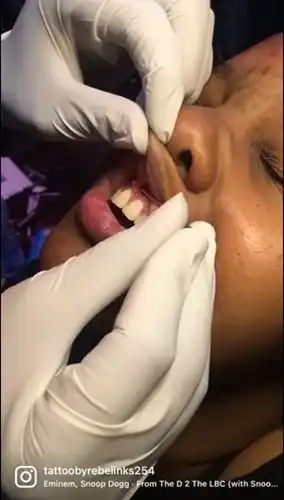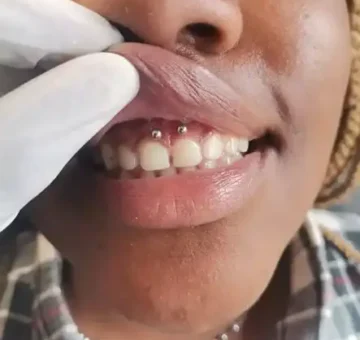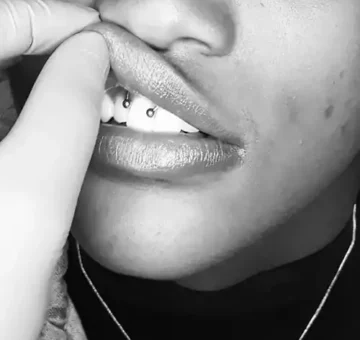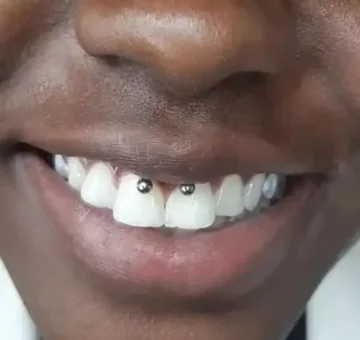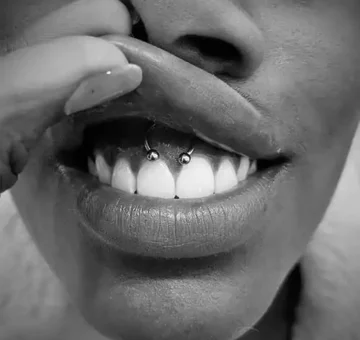Smiley Piercing in Nairobi, Kenya
A Smiley Piercing is a type of oral piercing that goes through the frenulum—the small, thin piece of tissue connecting your upper lip to your gums. It’s called a “Smiley” because the jewelry, typically a small hoop or barbell, is only visible when you smile, adding a subtle yet eye-catching touch to your expression.
Smiley Piercings
Here’s what you should know about Smiley Piercings:
- Placement: It’s a delicate, less noticeable piercing located inside the mouth, making it both subtle and playful.
- Procedure: The piercing is done with a small needle, with minimal discomfort since the frenulum is thin.
- Healing and Care: Healing usually takes 4 to 12 weeks. Proper aftercare, like rinsing with a saline solution, is important for a smooth recovery.
- Jewelry: Small rings or barbells are often used to prevent discomfort, as larger pieces can rub against the gums or teeth.
Smiley piercings are popular among those who want a hidden, unique piercing that adds an unexpected touch to their smile.
Smiley Piercing Procedure
The Smiley Piercing procedure is straightforward, quick, and generally low on the pain scale. Here’s a step-by-step breakdown of what happens:
- Preparation
– Our piercer will begin by examining the frenulum (the small tissue connecting your upper lip to your gums) to ensure it’s suitable for piercing. Not everyone has a frenulum thick enough to support jewelry.
– You’ll rinse your mouth with an antiseptic solution to reduce bacteria and ensure a clean area for the piercing. - Marking: Our piercer marks the spot on the frenulum where the piercing will go. This marking ensures accurate placement for both appearance and comfort.
- Clamping (Optional): Some of our piercers use a small clamp to hold the frenulum in place. Since the frenulum is thin and delicate, this step helps keep it steady for a precise and quick piercing.
- Piercing: Using a small-gauge, sterilized needle, our piercer quickly punctures the frenulum at the marked spot. Many people report that this step feels more like a pinch than a significant pain.
- Jewelry Insertion: A small piece of jewelry, like a captive bead ring or a horseshoe ring, is inserted. For first-time piercings, our piercers often recommend lightweight, hypoallergenic jewelry (such as titanium or surgical steel) to avoid irritation.
- Aftercare Instructions: Our piercer will provide detailed aftercare instructions, including using a saline solution rinse, avoiding certain foods, and not touching the jewelry with your fingers or tongue.
Total Time and Healing
The whole process usually takes less than 10 minutes. Healing can take 4–12 weeks, with good aftercare essential to prevent infection or irritation.
Considerations before getting a Smiley Piercing
Getting a smiley piercing, also known as a lip frenulum piercing, is a personal decision, and there are several important considerations to keep in mind before going through with the procedure. Here are some key factors to consider:
- Piercing Studio Selection
– Research reputable piercing studios or professional piercers in your area. At Rebel Inks Tattoo Removal and Piercings Parlour we have a team of professional body piercing experts that can and have successfully done many Septum Piercings Contact Us Today for any inquiries.
– Ensure the studio maintains high standards of cleanliness and follows strict sterilization practices. - Piercer Qualifications
– Verify that your piercer is experienced, licensed, and knowledgeable about smiley piercings.
– Ask to see their portfolio of previous work and inquire about their qualifications. - Placement and Jewelry Style
– Discuss the placement of the smiley piercing with our piercer. It should be in a location that suits your anatomy and preferences.
– Choose the style of jewelry you want, such as a small circular barbell or captive bead ring. - Pain Tolerance: Understand that pain perception varies from person to person. Most individuals describe smiley piercings as relatively quick and only moderately uncomfortable.
- Healing Time and Aftercare
– Expect the healing process to take around 6 to 8 weeks. During this time, proper aftercare is essential.
– Commit to maintaining good oral hygiene, which includes rinsing with saline solution after meals and avoiding smoking or alcohol during healing. - Jewelry Sizing: The initial jewelry may be slightly longer to accommodate swelling during the healing period. You can switch to a smaller piece once the piercing has healed.
- Oral Health: Ensure you have excellent oral hygiene practices in place before getting the piercing. This helps reduce the risk of infection.
- Speech and Eating Adjustments: Be prepared for minor speech and eating adjustments during the initial healing period. Softer foods may be easier to consume.
- Infections and Complications: Understand the potential risks, including infection, migration, or rejection. Be vigilant for signs of infection and seek prompt medical attention if needed.
- Allergies: If you have known allergies or sensitivities to certain metals or materials, discuss this with your piercer to select suitable jewelry.
- Visibility: Keep in mind that a smiley piercing is visible when you smile or lift your upper lip. Consider how this may impact your professional or social life.
- Removal and Scarring: If you decide to remove the piercing, know that the hole may close relatively quickly, but some scarring may remain.
- Commitment: Consider the long-term commitment to the piercing. Removing it may result in some scarring or visible hole closure.
- Professional and Social Implications: Evaluate how a smiley piercing may affect your daily life, especially in professional or conservative environments.
Before getting a smiley piercing, consult with your chosen piercer about any specific concerns or questions you may have. Take your time to make an informed decision, prioritize safety, and ensure that you are comfortable with the process and aftercare responsibilities.
Smiley Piercings FAQ’s
Pain and Healing for a Smiley Piercing
A Smiley Piercing typically causes mild to moderate pain during the procedure, often described as a quick pinch due to the thinness of the frenulum tissue. Here’s what to expect in terms of pain and healing:
Pain During the Procedure
- Pain Level: Most people rate the pain as low, typically around a 2 or 3 out of 10. Since the frenulum has fewer nerve endings, it’s generally less painful than other oral or lip piercings.
- Sensitivity: Some sensitivity may be felt during the actual puncture, but it’s usually brief and tolerable.
Healing Process
- Healing Time: Smiley piercings usually heal within 4–12 weeks, with proper aftercare.
- Initial Days: Swelling and slight tenderness are common for the first few days. During this time, it’s essential to stick to recommended aftercare routines to prevent infection and reduce discomfort.
Possible Issues and Care
- Gum and Tooth Sensitivity: Over time, jewelry might rub against the gums or teeth, potentially causing enamel wear or gum recession. Using smaller, high-quality jewelry can help mitigate this.
- Signs of Infection: Watch for prolonged swelling, intense pain, or discharge. If you notice any of these, consult a piercer or healthcare provider.
With attentive aftercare, a Smiley Piercing can heal smoothly and become a fun, low-maintenance addition to your style! Let me know if you’d like more details on specific aftercare practices or jewelry options for healing.
Smiley Piercing Aftercare
Aftercare for a Smiley Piercing is crucial to ensure a smooth healing process and to prevent infections or complications. Here’s a detailed guide:
- Daily Saltwater Rinse
– Frequency: Rinse your mouth with a saline solution (a mixture of sea salt and warm water) 2–3 times a day, especially after meals.
– How to Rinse: Swish the solution in your mouth for 30–60 seconds, then spit it out. Avoid swallowing. - Oral Hygiene
– Brushing: Brush your teeth gently, avoiding direct contact with the jewelry for the first few weeks. A soft-bristled toothbrush can help reduce irritation.
– Mouthwash: Use an alcohol-free, antimicrobial mouthwash to keep your mouth clean. Alcohol-based rinses can irritate the piercing and prolong healing. - Avoid Touching or Playing with Jewelry
– Avoid touching the piercing with your fingers or tongue to minimize irritation and bacteria exposure.
– Refrain from moving or twisting the jewelry, especially during the initial healing period. - Watch Your Diet
– Foods to Avoid: Stay away from spicy, acidic, or very hot foods and beverages that could cause irritation.
– Limit Smoking and Alcohol: Both smoking and alcohol can delay healing, so try to minimize or avoid these until your piercing is fully healed. - Avoid Trauma to the Piercing
– Be cautious while brushing your teeth or eating to avoid accidentally bumping or snagging the jewelry.
– If you play sports or are very active, consider wearing a mouthguard for extra protection. - Monitor for Signs of Infection
– Normal Healing: Some redness, mild swelling, and slight tenderness are typical during healing.
– Signs of Infection: Seek help if you notice persistent swelling, throbbing pain, yellow or green discharge, or a foul smell. - Choose the Right Jewelry
– Consider starting with hypoallergenic metals like titanium or surgical steel to minimize irritation.
– If you experience gum or enamel sensitivity, consider switching to a smaller or differently shaped piece of jewelry to reduce contact with teeth and gums.
Healing Duration
The average healing time for a Smiley Piercing is 4–12 weeks. Consistent aftercare helps the piercing heal faster and prevents complications.
Following these aftercare steps will help promote healthy healing and keep your Smiley Piercing looking great! Let me know if you’d like more tips on long-term care after it’s healed.
Smiley Piercing Jewelry
Choosing the right jewelry for a Smiley Piercing is essential for both comfort and aesthetic appeal. Here are some popular jewelry options and tips for selecting the best piece:
- Captive Bead Ring
– Appearance: A circular ring with a small bead that “captures” the ends of the ring.
– Benefits: The bead sits in the center, adding a subtle decorative touch that’s visible when you smile.
– Considerations: Captive bead rings come in various sizes; a small gauge (like 16g or 18g) is typically recommended to minimize weight and reduce rubbing on teeth. - Circular Barbell
– Appearance: Shaped like a horseshoe with beads or small decorative ends on either side.
– Benefits: Circular barbells offer a stylish, symmetrical look and are often available with interchangeable ends for added customization.
– Considerations: Lightweight barbells with smooth ends work best to avoid excessive contact with gums or teeth. - Seamless or Segment Ring
– Appearance: A simple, smooth ring with no visible opening, creating a seamless look.
– Benefits: These rings are comfortable and subtle, making them a good choice if you want something low-profile that minimizes irritation.
– Considerations: Segment rings can be a bit tricky to insert and remove, so professional help might be needed.
Materials to Consider
- Hypoallergenic Metals: Titanium and surgical stainless steel are ideal for initial piercings due to their biocompatibility and resistance to corrosion.
- 14k or 18k Gold: Gold is another safe option, but ensure it’s solid (not plated) to avoid reactions. Avoid wearing gold in a new piercing, as it’s softer and can bend or tarnish.
Choosing the Right Size
- Gauge (Thickness): Typically, Smiley Piercings use 16g or 18g jewelry. Thinner gauges may be more comfortable, but they also make the piercing more prone to shifting.
- Diameter: Choose a small diameter (6–8 mm) to ensure a snug fit that stays close to the frenulum and minimizes contact with teeth.
Jewelry Tips for Healing and Comfort
- Smooth Edges: Choose jewelry with rounded or flat ends to avoid gum irritation.
- Lightweight Options: Lighter pieces reduce strain on the frenulum and prevent discomfort during healing.
When choosing smiley piercing jewelry, consider factors such as your personal style, comfort, and the size that suits your anatomy. Additionally, ensure that the jewelry is made from safe materials such as surgical steel, titanium, niobium, or biocompatible plastics to minimize the risk of allergic reactions or complications. Our piercer can help you select the most suitable style and size of jewelry for your smiley piercing.
Cost of a Smiley Piercing in Nairobi, Kenya
The cost of a Smiley Piercing can vary depending on location, studio reputation, and the experience of the piercer. Here’s an overview of what you might expect:
Average Cost Range
- General Price: Smiley piercings typically range from Ksh. 1,500 to Ksh. 2,500
- High-End Studios: In well-known studios or high-demand urban areas, prices may go up to Ksh. 2,500 or more due to factors like specialized equipment, premium jewelry, and experienced piercers. At Rebel Inks Tattoos, Tattoo Removal, and Body Piercings Parlour we have some of the best and experienced professionals in smiley piercings.
Factors Affecting Cost
- Location: Prices can vary based on city and country. Studios in major cities or high-cost-of-living areas usually charge more. Rebel Inks Tattoos, Tattoo Removal, and Body Piercings Parlour is located in the heart of the Central Business Disrict (CBD) in Nairobi, Kenya, and is easily accessible to both locals and foreigners in the country.
- Jewelry Quality: The initial jewelry can affect the price. Hypoallergenic materials like titanium or 14k gold may come at a higher cost.
- Piercer’s Experience: A piercer with years of experience or specialization in oral piercings might charge more than less experienced piercers, which can be worth the investment for quality and safety. At Rebel Inks Tattoos, Tattoo Removal, and Body Piercings Parlour we have experienced professionals who offer quality and premium services.
Additional Costs
- Aftercare Products: At Rebel Inks Tattoos, Tattoo Removal, and Body Piercings Parlour we provide a saline solution or aftercare kit for an extra Ksh. 500 –Ksh. 1,000
- Jewelry Upgrades: If you want to switch to high-end or custom jewelry after healing, expect an additional charge ranging from Ksh. 300 to Ksh. 1,000 or more, depending on materials.
Smiley Piercing Cost Breakdown Table
Component / Package | Estimated Cost (KES) | What’s Included / Notes |
Procedure + base jewelry | 1,500 – 2,500 | Basic steel or titanium, minimal ornamentation; standard studio hygiene |
Jewelry material upgrade | 300 – 1,000 | Titanium vs. steel, maybe decorative ends, higher polish |
Aftercare kit / supplies | 500 – 1,000 | Saline rinse, cleaning solution or instructions |
Follow-up / check-ups | 200 – 500 (if needed) | We might at times include it or charge a small fee |
Total – Basic Package | 1,500 – 2,500 | Standard piercing with starter jewelry |
Total – Enhanced Package | 2,500 – 4,000 | With upgraded jewelry, aftercare kit, maybe premium setting or piercer skill premium |
Investing in a reputable piercer can ensure better results and a safer procedure. If you’re thinking of getting it done, checking out the studio’s hygiene practices, portfolio, and customer reviews can also help in making an informed choice.
Possible side effects of Smiley Piercing
While a Smiley Piercing can be a fun and unique addition, it does come with potential side effects. Here are some of the common risks and side effects to be aware of:
- Gum Irritation and Recession
– Cause: Jewelry that rubs against the gums can cause irritation or even gum recession over time, especially if it’s too large or heavy.
– Prevention: Choosing smaller, lightweight jewelry and ensuring proper placement can reduce this risk. Regular dental check-ups can also help monitor any gum health changes. - Tooth Enamel Wear
– Cause: Constant contact with metal jewelry can wear down tooth enamel, increasing the risk of sensitivity, chipping, or other dental issues.
– Prevention: Selecting smooth, snug-fitting jewelry and periodically removing or resizing the piercing can help protect teeth. - Infection
– Cause: Bacteria in the mouth can easily cause infections if proper aftercare isn’t followed, especially in the early stages of healing.
– Symptoms: Redness, swelling, pain, and discharge are common signs of infection.
– Prevention: Rinsing with a saline solution, avoiding touching the jewelry, and following proper aftercare instructions minimize this risk. - Allergic Reactions
– Cause: Some people may be allergic to certain metals, especially nickel, which can cause swelling, itching, or rash.
– Prevention: Using hypoallergenic materials like titanium or solid gold reduces the risk of allergic reactions. - Scarring
– Cause: If the piercing is removed or rejected, it may leave behind a small scar on the frenulum.
– Prevention: Properly sized jewelry and good aftercare can help minimize trauma to the area, reducing the risk of scarring.
When to Seek Help
Persistent swelling, intense pain, pus, or a foul smell may indicate an infection or other issue that needs professional attention, Contact Us immediately.
Get In Touch
For more information on the list above and any other special services,please call or come in for free consultation
Testimonials
After he pierced my industrial piercing and seeing his amazing work, I feel even more excited about getting my tattoo with him in January. I’m really looking forward to it!
I am extremely happy with my new 'Safari' tattoo from Eric at Rebel Inks! The quality of the artwork is fantastic. Eric is a true professional and an amazing artist.
The preparation and design process was thorough and collaborative. He was very patient with my specific requests, including making sure all the elements, which hold personal meaning, were perfect.
The service was friendly and highly professional from start to finish. Despite the 8-hour session, Eric was a pleasant person to spend the time with.
The aftercare guidance and follow-up have been excellent and careful, which has made the healing process easy and better than expected.
I highly recommend Eric for anyone looking for a thoughtful, talented, and caring tattoo artist.
I recommend them 💯
I would definitely recommend if you’re thinking of getting a piercing!
The staff were super friendly, explained everything clearly, and made me feel so at ease. They answered all my nervous questions (and I had many questions),
They walked me through the whole process, gave detailed aftercare instructions, and even followed up afterward to check how I was healing 🫶
Clean, professional, and full of good vibes.
Would 100% recommend . Definitely making a second trip here.
This was the second tattoo I got and I wish I could have come to Eric for my first one! He gave me really great after-care directions for the tattoo as well as a little jar of his own Vaseline-type stuff to put over my tattoo while it was healing! He even put second skin over my tattoo so that I didn’t have to worry about it for the first few days. Now THAT’S good service. My first tattoo artist didn’t do none of that lol.
After the session Eric didn’t rush me and my friend out, he chatted with us and even when he found out I was an artist too— really encouraged me to keep creating and to find a community of artists to support me. I almost cried because I’ve had such a hard time with my own art the past couple of years, it meant so much to me to have a fellow very talented artist say that to me. 🤍🤍🤍
Eric you’re amazing, don’t ever stop creating and just know you’ve impacted lives all over the world!🫶🏻 thanks so much for everything!!
From the moment I walked in, Eric was professional, welcoming, and attentive. He made sure I was comfortable throughout, provided everything I needed, and explained every step of the process. The tattooing itself was unbelievably smooth - I genuinely felt no pain compared to my previous tattoos over the last 22 years.
Eric also gave me excellent aftercare guidance and products, and thanks to that, my tattoo healed beautifully. The attention to detail, precision, and shading are absolutely stunning. This is hands-down the best tattoo I've ever had, and I will be flying back to Nairobi for any future ink.
If you want incredible art, a professional experience, and a talented artist who truly cares about his clients, Rebel Ink is the place to go!
From start to finish, the service was exceptional. The piercer was professional, knowledgeable, and made me feel completely comfortable. The cleanliness of the place was above and beyond — everything was spotless and hygienic, which really put me at ease. Highly recommend for anyone considering a piercing!
Shout out to Eric😘
We ended up changing the jewelry three times to ensure I had the best fit and avoided any signs of rejection, and he always listened to my suggestions as a client, which I really appreciated. Now, three months in, my piercing is healing beautifully, with no sign of rejection. Highly recommend for anyone who values a piercer who cares about your comfort and healing journey!
What stood out the most was the aftercare Eric checked in with me even three weeks later to see how the tattoo was healing. That kind of follow-up shows how much he truly cares about his work and his clients.
I’m very satisfied and will definitely be coming back for my next piece. Highly recommend!
The piercing wasn't as painful as I had thought and the process was quick and satisfactory. I love it!!!
The piercing is healing well thanks to the aftercare instructions and follow-up. I would highly recommend Rebel Inks
Eric also did a belly button piercing for a friend, guiding her through the process, doing the piercing and then explaining the after care to her.
The shop is on the 3rd floor, with the entrance to the stairs near an alleyway on the left. The shop is perfect size, clean, and attractive looking. The mural is pretty dope.
Thank you for the amazing service! 🔥👅✨
I got piercibgs there and the process was really good. My biggest concern was hygiene but that wasn't an issue at all, they use new needles and they sanitize them.
The service itself was also welcoming.
I was informes of everything i needed to know beforehand.
10/10 would recommend!
Eric was so calm and patient with my almost 2 year old lady. It was such a clean and hygienic process. We will definitely be back for our second rounds of piercings and maybe even another tattoo!
They assess the area before any art and advise one accordingly. They also give one post clean up process and also do a check up after the body art projects. Overall, I loved my experience and I’m hooked. 👍
Will definitely come back next time I’m in town 🙂
He listened to what I actually wanted and made sure he could fit in the time before I flew back home.
The shop is clean & private and is easy enough to find.
Eric has even checked in a couple of times since to make sure all is good.
I would totally recommend Eric! I absolutely love my Elephants!
I had a very easy healing period and always follow up from Eric to check on my progress...I would highly recommend if you are a first timer because from my experience all went very well and attention to detail
Thank you for a good job and looking forward to send all my friends your way
And all the best with the new year 2025!
From the moment I walked in, the staff was super friendly and made me feel at ease. The studio had a clean, professional atmosphere, which immediately put me at ease. My piercer was incredibly skilled and explained every step of the process, ensuring I was comfortable the entire time. The piercing was quick and practically painless, and the aftercare instructions were clear and easy to follow. I can tell they really care about the health and safety of their clients.
Overall, a fantastic experience—I highly recommend Rebel Inks and Tattoos for anyone looking to get pierced or tattooed!
They do follow up after their services
Eric's Studio isn’t just a place to get a tattoo—it’s an experience. The combination of professionalism, artistic talent, and a welcoming environment makes it a standout destination for anyone considering a tattoo.
I highly recommend Eric’s Studio to both first-timers and seasoned tattoo enthusiasts. If you’re looking for a high-quality tattoo and an enjoyable experience, this is the place to go.
I would definitely recommend their services again and again
Thank you Rebel Ink
My piercings are healing ❤️🩹 well
I would 💯 recommend
I will definitely come back for more .
Two, all the equipments he used for the piercings were new and/or sterilised.
Three, the parlour itself was very clean and was up to par with the hygiene standards.
Four, Eric provided effective aftercare instructions, making sure I knew exactly how to take care of my new piercings and he kept in touch and continues to do so, to check on the healing progress.
I highly highly highly recommend this place!!!
Would definitely recommend them to friends and go back for other piercings
Not only was the piercing process smooth, but he also provided thorough aftercare instructions, making sure I knew exactly how to take care of my new piercings. What really impressed me was that he keeps in touch to check on how the healing is progressing – a sign of true care for his clients.
The shop maintains a high standard of hygiene, and the atmosphere is welcoming and comfortable, which really added to the positive experience. I highly recommend this place to anyone looking for a professional and caring experience. I’ll definitely be coming back for any future piercings!
My appreciation for the excellent customer service I received. The follow-ups were prompt, and I truly appreciated the gentleness and professionalism throughout. Thank you!"
"Looking for professional eyebrow microshading removal? Look no further!"
The customer care is top tier 👌🏾👌🏾.
Wonderful place to get tattoos and piercings. 💯💯
Eric goes ahead to follow up on his clients progress and gives good advice each time I reach out to him.
I would recommend Reble tattoos anytime.
Good job bro we really appreciate.
Ohh and the price is very fair.
The environment was clean , procedure was sterile and the jewelry used are of the best quality.
He followed up with me during the healing process, he educated me on what I needed to do for my aftercare.
Eric is confident, skilled , experienced and the best piercer. Highly recommend Rebel inks.✨
Definitely recommend!
Great experience.
Eric definitely know what he is doing .
I got exactly what I wanted 2 tiny tats on the same finger .
He was kind and patient throughout the session.
Healing process has been good .
Aftercare services were given and regular checkups on the healing process were done.
I would 💯recommend.
Eric gave me the best reception as it was my first time there,and made me trust him all the way. I appreciate good services.
There services are also affordable not to forget 😊.
He was also invested in the aftercare and would ensure I follow the do's and don'ts in taking care of the tattoo and ensuring proper healing and maximum ink retention.
Would highly recommend Rebel Inks Tattoos.
Rebel Inks Tattoo offer the best,affordable and quality tattoo removal services.If you have unwanted ink,choose Rebel Inks Tattoo,they're the best of the best and the professionalism is a top notch.They ensure you're free from unwanted ink with their Laser Tattoo Removal Technology...
I did a Laser Tattoo Removal with them and i can attest they're the best....
Kudos Eric...
I highly recommend.
It was a generally good experience with good hygiene during the piercing process and has been a smooth healing process.... 10/10
tips. Highly recommend 👍🏽
100% recommendable.
I was particularly impressed with Eric's attention to hygiene. He thoroughly cleaned the room before I entered, sanitized all of the equipment he would be using, and changed gloves between each ear. This level of cleanliness gave me great confidence in his professionalism.
Eric's commitment to customer service did not end on the day of the piercing. He followed up with me regularly throughout the healing process to ensure that I was following the aftercare instructions and that my earlobes were healing properly.
I highly recommend Rebel Inks to anyone in Nairobi who is considering getting a piercing. Eric is a highly skilled and experienced piercer who takes great pride in his work.
So I Check all the boxes below and more:
Customer Care: ✔️
Professionalism : ✔️
Cleanliness ✔️
Price: ✔️
After care service ✔️
Thanks and good job, Eric
The place is neat and clean and the equipments he used were also fine standards. Really appreciate his following up with me on the healing 🤗
I WOULD HIGHLY RECOMMEND THEIR SERVICES to everyone. Actually what you see on their website is EXACTLY what you will get. Keep up the good work Rebel inks Tattoos.
The infection is now gone. I would definitely recommend!
Can recommend this place totally and would go back there anytime!
Thanks!
OUR LOCATION
Areas We Serve
NAIROBI
KIAMBU
KAJIADO
MACHAKOS


